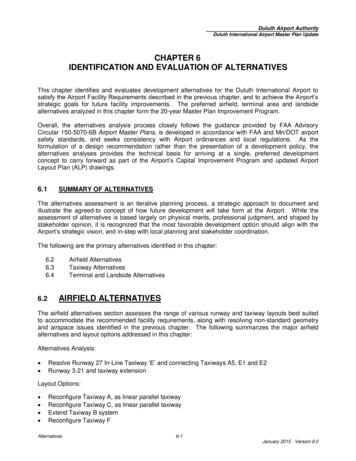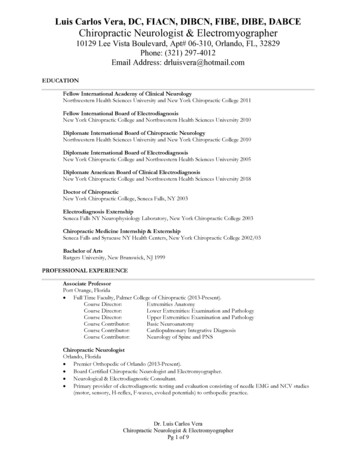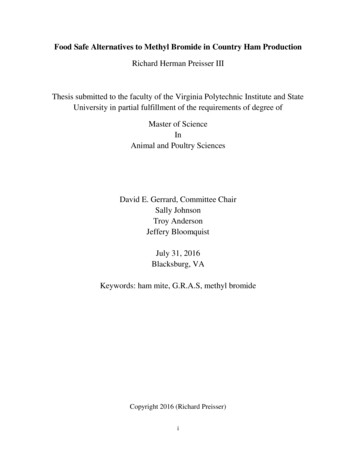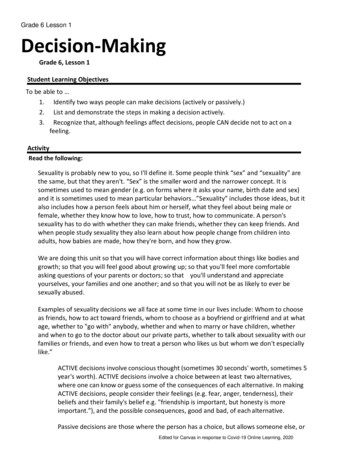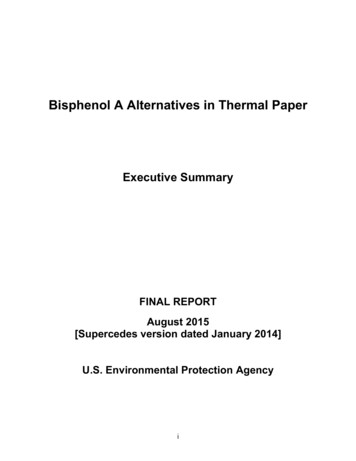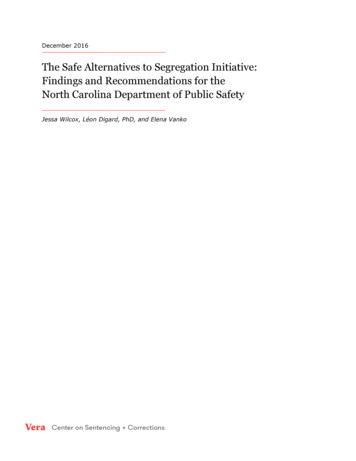
Transcription
December 2016The Safe Alternatives to Segregation Initiative:Findings and Recommendations for theNorth Carolina Department of Public SafetyJessa Wilcox, Léon Digard, PhD, and Elena Vanko
2016 Vera Institute of Justice. All rights reserved.Additional copies can be obtained from the communications department of the VeraInstitute of Justice, 233 Broadway, 12th floor, New York, New York, 10279,(212) 334-1300. An electronic version of this report is available for download on Vera’s website, www.vera.org.Requests for additional information about this report should be directed to Sara Sullivan atthe above address or to contactvera@vera.org.2Vera Institute of Justice
Executive SummaryIn recent years, a diverse range of international and national bodies, advocates, federal and statepolicymakers, and corrections practitioners have called for prisons and jails to reform their useof segregation, also known as solitary confinement or restrictive housing. Whether citing thepotentially devastating psychological and physiological impacts of spending 23 hours per dayalone in a cell the size of a parking space, the cost of operating such highly restrictiveenvironments, or the lack of conclusive evidence that segregation makes correctional facilities orcommunities safer, these voices agree that change and innovation are necessary.In 2015, with funding from the U.S. Department of Justice, Bureau of Justice Assistance, theVera Institute of Justice partnered with the North Carolina Department of Public Safety (DPS)to help DPS reduce its use of segregation. Vera’s assistance included conducting an assessmentof DPS’s use of segregation and providing ways to decrease its use.Key ReformsDuring the initiative, DPS began instituting several remarkable reforms, including:§ A prohibition on the use of segregation for youth under 18 years of age;§ The establishment of Therapeutic Diversion Units as an alternative to restrictive housingfor people with greater mental health treatment needs;§ The creation of a Rehabilitative Diversion Unit to help transition people fromsegregation to regular population; and§ Mandated staff training on communication and de-escalation tools, to help limit the useof restrictive housing.Key FindingsThis report presents the findings of Vera’s assessment, which come from a period prior to theenactment of many of these reforms but provide a useful baseline against which DPS canmeasure the impact of recent and future changes. In conducting its assessment, Vera adopted abroad definition of “restrictive housing” to include any housing unit which satisfies twoconditions: it (1) holds incarcerated people separately from regular population and (2) placesgreater restrictions on out-of-cell time, congregate activity, and access to programming than inregular population. Therefore, housing units such as Death Row, which separated people fromregular population but did not place greater restrictions on them, were not included in ourassessment. Modified Housing (MODH) units, however, were included since Vera observed arange of practices in various MODH units, including some units where people received only twohours of out-of-cell time per day.3Vera Institute of Justice
At the time of Vera’s assessment, 44 of DPS’s 56 prisons held people in restrictive housing.On June 30, 2015, 3,432 people—just over 9 percent of the prison population—were in someform of restrictive housing. Excluding people held in MODH from the count would give arestrictive housing population of 2,952 on that date, or 7.9 percent of the incarcerated population.Vera’s findings not only touch on DPS’s use of different types of restrictive housing, but alsoexamine differences in its use between genders, age groups, racial and ethnic groups, and peoplewith different levels of mental health treatment needs.People housed in almost all restrictive housing units were held inconditions of isolation and sensory deprivation.At the time of the assessment, DPS housed 7.9 percent of the prison population in restrictivehousing units characterized by conditions of extreme isolation and sensory deprivation. Peoplein these units spent a minimum of 23 hours a day in their cell with severely limited interactionwith other people. Out-of-cell time consisted primarily of individual recreation in a small secureenclosure for one hour a day, five days a week. There was very little, if any, opportunity forprogramming or congregate activity.Disciplinary Segregation was used frequently as a sanction, even for lowlevel infractions.On June 30, 2015, almost 30 percent of the people in restrictive housing were there as asanction for a disciplinary infraction. Disciplinary segregation was given as a sanction for 99percent of incidents with a guilty finding, although for one-third of these incidents, the sentencewas suspended and then lifted if the person remained infraction-free for 180 days. The top threeinfractions resulting in a disciplinary segregation sanction were “disobey an order,” “profanelanguage,” and “unauthorized tobacco use.” These three infractions accounted for 40 percent ofall disciplinary segregation sanctions.Other types of restrictive housing were characterized by long stays.DPS had three different housing classifications for incarcerated people held in restrictivehousing with an indeterminate length of stay: Intensive Control (ICON), Maximum Control(MCON), and High Security Maximum Control (HCON), with HCON being the most restrictive.On June 30, 2015, 37 percent of all people in restrictive housing were in any of these types ofControl housing. Reasons for placement in Control housing ranged from repeatedly disruptivebehavior to posing an imminent risk to the life or safety of others. The average length of stay inICON was approximately nine months; it was twenty-one months for MCON, and almost fiveyears for HCON.During the initiative, DPS enacted several reforms to Control housing, including the creationof a Rehabilitative Diversion Unit (RDU) designed to help people transition from Control toregular population through the provision of targeted behavioral programming and increasingprivileges, congregate activity, and out-of-cell time.4Vera Institute of Justice
Certain groups were overrepresented in restrictive housing.Youth, young adults, people with mental health needs, and racial minorities wereoverrepresented in DPS’s restrictive housing units. On June 30, 2015, 32 percent of youth(under 18 years of age) and 17 percent of young adults (18-25 years old) were in restrictivehousing, compared to 8 percent of people 26 and older. Incarcerated people who requiredmental health treatment involving psychotropic medication and therapy, but who did notrequire placement in a designated mental health unit, made up 8 percent of the regularpopulation but 14 percent of the population in disciplinary segregation and 24 percent ofControl housing.Echoing the fact that racial and ethnic minorities are generally overrepresented throughoutthe criminal justice system in the United States, racial minorities were disproportionatelyexposed to restrictive housing. For example, while 35 percent of white incarcerated people hadspent at least one night in restrictive housing during the year prior to Vera’s assessment, thiswas true of 47 percent of black individuals and 50 percent of Native American incarceratedpeople.DPS released some people from segregation directly to the community.Releasing people directly from restrictive housing to the community can make an alreadydifficult transition even more challenging. During the 12 months ending on June 30, 2015, DPSreleased 1,832 incarcerated people directly from restrictive housing to the community. Fortyfive percent of these people had spent over one month in segregation directly prior to beingreleased; 15 percent had spent over six months.Key RecommendationsVera commends DPS on the steps it has already taken to reform its use of restrictive housingand offers recommendations that will further its efforts to safely reduce that use. The full reportdetails numerous specific recommendations for DPS, including:§ Reduce the number of disciplinary infractions eligible for segregation sanctions andreduce the maximum length of segregation sanctions;§ Expand available alternative sanctions to disciplinary segregation, expand and track thecurrent practice of pre-disciplinary counseling, and encourage other informal ways toresolve minor offenses;§ Maintain and enhance beneficial programming, supports, and structured activities inregular population, to help prevent people from engaging in behaviors that may lead totheir placement in restrictive housing;§ Strengthen procedural safeguards around Control housing to ensure that it is truly usedas a last resort, only when necessary, and for as short a time as possible, with a cap onthe length of time permitted in Control;5Vera Institute of Justice
§§§§Enact policies that prohibit people with serious, persistent mental illness from beingplaced in any form of restrictive housing that limits meaningful access to socialinteraction, environmental stimulation, and therapeutic programming;Take individuals’ release dates into account when using restrictive housing; usealternative disciplinary sanctions, or placement into housing units with both greatersecurity and a structured reentry process, to ensure that people are not released directlyfrom restrictive housing to the community;Improve the conditions of confinement in all restrictive housing units to reduce thenegative effects of segregation, including by increasing out-of-cell time and recreation,minimizing isolation and idleness, and providing opportunities for rehabilitativeprogramming; andContinue and expand the provision of staff training on de-escalation and communicationskills, and expand trainings on mental decompensation and mental health needs.As the North Carolina Department of Public Safety continues implementation of current andfuture reforms, Vera is confident that the department will capitalize on its strengths, learn fromthe experience of others in the field, and use this report to facilitate continued reforms to the useof restrictive housing, in order to improve the lives of those who live and work in NorthCarolina’s prisons and the broader community.6Vera Institute of Justice
Table of ContentsI. BACKGROUND10II. VERA’S ASSESSMENT PROCESS13Administrative Data AnalysisPolicy ReviewSite Visits131414III. OVERVIEW OF THE NORTH CAROLINA DEPARTMENT OF PUBLIC SAFETY15Restrictive HousingCommitment to Reform1517IV. FINDINGS, REFORMS, AND RECOMMENDATIONS19A. System-wide Findings & RecommendationsFindingsRecommendationsB. Restrictive Housing for Disciplinary PurposesFindingsRecommendations for Reducing Use of and Changing Conditions in RHDPC. Restrictive Housing for Administrative PurposesFindingsRecommendations to Reduce Use of and Shorten Length of Stay in RHAPD. Control HousingFindingsReforms to Control HousingRecommendations to Reduce the Use of and Change Conditions in RHCPRecommendations for the RDUE. Modified HousingFindingsReforms to Modified HousingRecommendations for Modified HousingF. Protective ControlFindingsRecommendations for Protective ControlG. Mental Health Needs and Restrictive HousingFindingsReforms in Mental Health Care and Restrictive HousingRecommendations Regarding Mental Health and Restrictive HousingH. Youthful OffendersFindingsReforms: The Youthful Offender ProgramRecommendations for the Youthful Offender ProgramI. Young AdultsFindingsRecommendations for Young 555758636367677070727Vera Institute of Justice
J. Women in Restrictive HousingFindingsRecommendations Regarding WomenK. Release from Restrictive Housing Directly to the CommunityFindingsRecommendations747476787879V. CONCLUSION80APPENDIX: SUMMARY OF RECOMMENDATIONS818Vera Institute of Justice
About this reportIn 2015, with funding from the U.S. Department of Justice, Bureau of Justice Assistance, theVera Institute of Justice partnered with the North Carolina Department of Public Safety (DPS)to conduct a yearlong assessment of the agency’s use of restrictive housing, a type ofincarceration that removes a person from the general population and confines them to anisolated cell for 22-24 hours a day with limited human interaction and minimal, if any,constructive activity.1 This report outlines the findings of that assessment and providesrecommendations to DPS on how to safely reduce its use of restrictive housing. This reportincludes (1) background information on restrictive housing and the movement to reduce its use,(2) Vera’s assessment process, (3) an overview of restrictive housing in DPS and thedepartment’s commitment to reform, (4) Vera’s findings, a brief overview of reforms that havebeen implemented in the past year, and Vera’s recommendations, and (5) a conclusion.1Restrictive housing is also referred to as segregation, isolation, or solitary confinement. This reportwill generally use the term “restrictive housing,” since this is the language used by DPS.9Vera Institute of Justice
I. BackgroundOver the past several decades, corrections agencies in the United States have increasingly reliedon the use of restrictive housing—the most extreme form of confinement—as a routinemanagement strategy. Recent reports have estimated the number of people in restrictivehousing in prisons nationwide to be between 80,000 and 100,000 individuals.2 The use ofsegregation remains a mainstay of prison management and control despite mounting evidencepointing to potentially devastating psychological effects on individuals placed there, theincreased expense accrued from housing people in restrictive housing compared to regularpopulation, and the harmful safety outcomes within institutions themselves and in thecommunities to which those who have been held under such severe conditions will return.3As these negative impacts have come to light, concern about the overuse of segregation hasgrown. A diverse range of national organizations, corrections officials, researchers,policymakers, and international organizations have called for the reform of these practices andthe development of more rehabilitative alternatives. Advocacy organizations such as theAmerican Civil Liberties Union have opposed the use of solitary confinement, and media outletslike Solitary Watch and The Marshall Project have published reports, news articles, and factsheets on the topic.4 The National Commission on Correctional Health Care recently issued aposition statement on isolation encompassing 17 principles and calling for the elimination of“prolonged solitary confinement” (defined as more than 15 consecutive days).5 And in 2016, theU.S. Department of Justice (DOJ) issued a report calling for widespread reform of restrictivehousing practices in the Federal Bureau of Prisons (BOP) and beyond.6 Subsequently, theObama Administration adopted the report’s recommendations for the BOP. Professionalorganizations representing corrections practitioners and administrators have also promotedchanges to this practice—the American Correctional Association recently passed new restrictive2Association of State Correctional Administrators and The Liman Program, Yale Law School, Time-InCell: The ASCA-Liman 2014 National Survey of Administrative Segregation in Prison, August 2015.These numbers do not include people in local jails, juvenile facilities, or immigration detention centers.3For psychological effects, see Stuart Grassian, “Psychiatric effects of solitary confinement,”Washington University Journal of Law & Policy 22 (2006): 325; and Craig Haney, “Mental health issuesin long-term solitary and “supermax” confinement,” Crime & Delinquency 49(1) (2003): 124-156.About increased expense, see Daniel P. Mears and William D. Bales, “Supermax Incarceration andRecidivism,” Criminology 47, no. 4 (2009): 1135. For lack of evidence of increased safety, seeNatasha Frost and Carlos E. Monteiro, “Administrative Segregation in U.S. Prisons” (Washington, DC:U.S. Department of Justice, National Institute of Justice, March 2016, NCJ 249749R.M), citing RyanLabrecque, “The Effect of Solitary Confinement on Institutional Misconduct: A Longitudinal Evaluation”(PhD diss., University of Cincinnati, 2015).4To view recent work by these organizations, see ry-confinement, http://solitarywatch.com/, andhttps://www.themarshallproject.org/?ref nav#.MIjJlTEOC.5National Commission on Correctional Health Care, “Position Statement: Solitary Confinement(Isolation),” nfinement-Isolation.pdf (accessed June28, 2016).6U.S. Department of Justice, Report and Recommendations Concerning the Use of RestrictiveHousing: Final Report (Washington, DC: U.S. Department of Justice, January 2016).10Vera Institute of Justice
housing standards and the Association of State Correctional Administrators established guidingprinciples regarding the use of restrictive housing.7 On the international level, in 2015, theUnited Nations General Assembly unanimously adopted the revised Standard Minimum Rulesfor the Treatment of Prisoners (known as the “Nelson Mandela Rules”), which prohibitindefinite solitary confinement and solitary confinement longer than 15 consecutive days, andwhich support specific restrictions on the use of solitary confinement for juveniles, pregnantwomen, and people with mental or physical disabilities.8 Although non-binding, the MandelaRules represent widely accepted international principles on the treatment of incarceratedpeople.9Against this backdrop, several jurisdictions have begun implementing policy changes toreduce the number of adults or youth held in restrictive housing, improve the conditions inrestrictive housing units, and facilitate the return of segregated people to a prison’s generalpopulation. These reforms have come through agency-driven changes, by state legislation, andthrough legal settlements.10 For example, Washington State implemented an innovative stepdown program as a pathway to get people out of long-term segregation, the New York legislaturepassed a law to keep people with serious mental illness from being placed in long-termsegregation, and California entered into a landmark settlement that ended indeterminatesegregation.11Building upon the growing interest in segregation reform, the Vera Institute of Justice(Vera) developed the Segregation Reduction Project in 2010 to foster reform throughcollaborative partnerships with state and local jurisdictions. In 2015, Vera expanded this workwith the Safe Alternatives to Segregation (SAS) Initiative. Through this initiative, Vera is7American Correctional Association, “Restrictive Housing Performance Based Standards” (2016),http://www.aca.org/ACA Prod IMIS/ACA Member/Standards Accreditation/Standards/RestrictiveHousing Committee/ACA Member/Standards and Accreditation/Restrictive Housing Committee/Restrictive Housing Committee.aspx?hkey 458418a3-8c6c-48bb-93e2-b1fcbca482a2; and Association ofState Correctional Administrators, “Restrictive Housing Policy Guidelines” 3019.8United Nations Standard Minimum Rules for the Treatment of Prisoners (the Nelson Mandela Rules),General Assembly Resolution 70/175, U.N. Doc. A/Res/70/175 (2015). Two U.S. corrections officials,and members of Vera’s Safe Alternatives to Segregation Initiative Advisory Council, were involved inthe drafting of the rules.9These international human rights norms regarding the use of solitary confinement have been furthersupported by the UN Committee Against Torture, the UN Special Rapporteur on Torture, and the UNGeneral Assembly.10For an example of agency-led change, see Dan Pacholke and Sandy Felkey Mullins, More thanEmptying Beds: A Systems Approach to Segregation Reform (Washington, DC: Bureau of JusticeAssistance, 2016); Rick Raemisch and Kellie Wasco, Open the Door: Segregation Reforms in Colorado(Colorado Department of Corrections, 2015); and Barbara Pierce Parker and Michael Kane, ReshapingRestrictive Housing at the South Dakota State Penitentiary (Boston, MA: Crime and Justice Institute,December 2015). New York Correction Law § 137 (6)(d)(i). For additional examples of legislativereform, see Colorado SB 11-176 (2011) and H1328 (2016), Nebraska LB 598 (2015), Connecticut SB75 (2016), and Texas HB 1083 (2015). For legal settlements, see Ashker v. Governor of California,Settlement Agreement C 09-05796 CW (N.D. California, 2015) (among other things, it no longerallows affiliated gang members to be sent to segregation based on affiliation alone).11See Peoples v. Annucci, 2016 U.S. Dist. LEXIS 43556 (S.D.N.Y., Mar. 31, 2016).11Vera Institute of Justice
partnering with the North Carolina Department of Public Safety (DPS) to assess DPS’ssegregation policies and practices, analyze outcomes of that use, and provide recommendationsfor safely reducing the use of segregation and enhancing the use of alternative strategies.1212The other jurisdictions working with Vera under this initiative are Nebraska, Oregon, New York City,NY, and Middlesex County, NJ.12Vera Institute of Justice
II. Vera’s Assessment ProcessVera, in partnership with the North Carolina Department of Public Safety (DPS), conducted anassessment of DPS’s use of restrictive housing in state prison facilities between May 2015 andMay 2016. Vera worked closely with DPS’s designated site coordinators, who are members of thedepartment’s leadership team, throughout the assessment. The assessment included threecomponents: analysis of administrative data, policy analysis, and site visits to key facilities.Administrative Data AnalysisTo gain a clearer understanding of how restrictive housing was being used in DPS facilities, Veraanalyzed administrative data relating to any person who was held in DPS custody for any lengthof time during the period from June 30, 2014 through June 30, 2015. As such, Vera receivedindividual-level data on 64,712 people, dating back to the start of their current sentences. Thedata included a number of variables relating to:§§§Incarcerated people’s characteristics, such as demographics, mental healthclassifications, security risk group (SRG) membership (more colloquially known as gangaffiliation), and sentence information;Movement files, detailing their placement in and out of restrictive housing statuses andmovement between and within facilities; andDisciplinary records, with information on infraction charges, pleas, hearing verdicts, andsanctions.Vera analyzed the data in a number of ways in order to understand who was being placed inrestrictive housing, the reasons they were placed there, and how long they stayed.In addition, June 30, 2015 was used in the analysis as a “snapshot” date. Analysis of the DPSpopulation and the use of segregation on this date describes the context in which Vera’sassessment started. This date, coming early in the Vera/DPS collaboration, also provides abaseline from which future changes to the use of restrictive housing can be measured. It doesnot, however, capture the impact of any reforms that were made during Vera’s assessment.Nevertheless, data provided by DPS for June 18, 2016, suggests that the population in restrictivehousing has decreased by 10 percent during the year following Vera’s data analysis.1313“North Carolina Division of Adult Correction & Juvenile Justice – Section of Prisons RestrictiveHousing Fact Sheet,” NCDPS, June 21, 2016. Please see Section IV for more details.13Vera Institute of Justice
Policy ReviewVera reviewed numerous policies provided by DPS including, but not limited to, policiesregarding segregation practices, the disciplinary process, medical and mental health services,and the new Youthful Offender Program. Additionally, DPS provided Vera with the StandardOperating Procedures (SOP) for every facility visited.Site VisitsVera’s assessment relies heavily on intensive site visits, where the assessment team had theopportunity to see policies in action and learn about practices on the ground. DPS’s sitecoordinators worked with Vera to ensure that Vera toured facilities with restrictive housingunits, specialized populations, and targeted programming. Vera visited a diverse selection ofDPS facilities, including:§§§§§§§§§§§Caledonia Correctional InstitutionCentral PrisonFoothills Correctional InstitutionMarion Correctional InstitutionMaury Correctional InstitutionMountain View Correctional InstitutionNorth Carolina Correctional Institution for WomenOrange Correctional CenterPasquotank Correctional InstitutionPolk Correctional InstitutionWarren Correctional InstitutionAt each facility, Vera completed a tour and conducted an informational meeting with thefacility superintendent and leaders, corrections officers, hearings officers, correctionalcounselors, other security personnel, mental health staff, and program staff. Additionally, Veraconducted focus groups of security staff, program staff, and incarcerated people who had spenttime in restrictive housing. Through these tours, in-depth meetings, and focus groups, theassessment team learned how segregation is used at each facility and the range of servicesprovided for segregated populations. The team also gained an understanding of disciplinarypractices, decision points for segregation placement, how and when alternative sanctions areused, procedures for placement in administrative segregation, and practices for review andrelease to the general prison population or community. Finally, the meetings gave facilityadministrators and staff an opportunity to share their strengths and challenges in general, aswell as those related specifically to DPS’s use of restrictive housing.14Vera Institute of Justice
III. Overview of the North CarolinaDepartment of Public SafetyThe North Carolina Department of Public Safety (DPS) oversees the care and custody of morethan 37,000 incarcerated people. DPS employs almost 20,000 people in 56 prison facilitiesaround the state. At the time of Vera’s assessment, 44 of these facilities had restrictive housingunits. Since the assessment, DPS has made some changes in its restrictive housing, such asconsolidating two Control housing classifications. The Findings section of this report will use thenames and housing units that were used during the time of the assessment. The Reforms sectionwill use the terms for the new housing units, as will the Recommendations section.Restrictive HousingAt the time of Vera’s assessment, DPS used the following forms of restrictive housing.Restrictive Housing for Disciplinary Purposes (RHDP)Incarcerated people who violate facility rules can be removed from regular population andplaced into RHDP as punishment.14 People are assigned to RHDP for a specific number of days,based on the severity of the infraction. At the time of Vera’s assessment, sanctions ranged from amaximum of 15 days for a Class D infraction to 60 days for a Class A infraction (the mostsevere). Incarcerated people have the option of pleading guilty to Class D-B infractions inexchange for receiving the sanction given for one lower class of infraction. People in RHDPremain in their cells all day, except for the opportunity to have out-of-cell recreation alone, onehour a day, five days a week.15 There were 48 RHDP Units at the time of assessment.Restrictive Housing for Administrative Purposes (RHAP)RHAP is the temporary removal of an incarcerated person from regular population toconfinement in a secure area. Length of stay in RHAP is capped at 60 days. There are fiveauthorized reasons for placing someone in RHAP: “(1) to protect staff or others from the threatof harm, (2) to minimize the risk of escape, (3) to preserve order where other methods of controlhave failed, (4) to provide necessary control while completing an investigation, or (5) to removesomeone from the population as a ‘cooling off’ measure.”16 People in RHAP remain in their cells,except for the opportunity to recreate alone one hour a day, five days a week.14North Carolina Department of Public Safety, Prisons Policy and Procedure Manual (“Policy andProcedure Manual”), Chapter B, Section .0200, “Inmate Disciplinary Procedures” (Issue Date:03/28/16).15In this section, information on conditions of confinement and out-of-cell time comes from Policy andProcedure Manual, Chapter C, Section .1200, “Conditions of Confinement” (Issue Date: 03/02/15).16Policy and Procedure Manual, Chapter C, Section .0300, “Restrictive Housing for AdministrativePurposes” (Issue Date: 05/10/16).15Vera Institute of Justice
Control HousingDPS had three distinct classifications, increasing in restrictiveness, for non-punitive,indeterminate restrictive housing: Intensive Control (ICON), Maximum Control (MCON), andHigh Security Maximum Control (HCON). For an incarcerated person in HCON to reenterregular population, he must first have been promoted to MCON and then promoted to ICON; aperson in MCON must have been promoted to ICON before reentering regular population.In 2016, DPS consolidated ICON and MCON into one status, Restrictive Housing for ControlPurposes (RHCP).Intensive Control (ICON)Intensive control was the long-term removal of individuals from general population,intended for “the control of offenders whose behavior has proven to be repeatedly disruptiveto the operations of the facility, non-compliant with instructions and orders, or as atransition following assignment to maximum control status.”17 People in ICON remained intheir cells except for the opportunity for one hour of out-of-cell recreation, five days a week,in a secure recreational enclosure. ICON housing status was reviewed every 180 days. At thetime of Vera’s assessment there were 15 ICON units.Maximum Control
The Safe Alternatives to Segregation Initiative: Findings and Recommendations for the North Carolina Department of Public Safety Jessa Wilcox, Léon Digard, PhD, and Elena Vanko . On June 30, 2015, 3,432 people—just over 9 percent of the prison population—were in some form of restrictive housing.
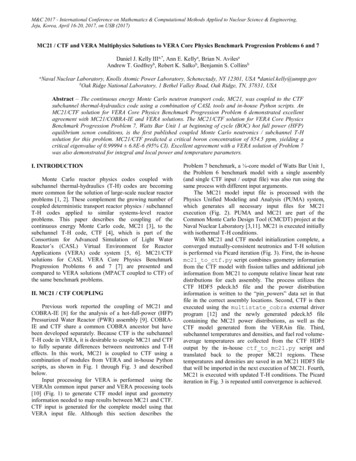
![[403] Vol. Cccxxxviii Over the Counter Sales 3.40 Including G.s.t .](/img/27/22195-gazette-11-may-2022.jpg)

